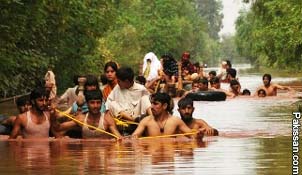|
 WHILE
Pakistan was still grappling with last year’s devastating
floods that marooned one-fifth of the country, it has again
been hit by the natural calamity causing devastation of
enormous magnitude. According to National Disaster
Management Authority, 5.3 million people have been affected
by this summer’s heavy rains in 23 districts of Sindh. Of
these, nine highly affected districts are: Badin, Mirpurkhas,
Tharparkar, Tando Muhammad Khan, Tando Allahyar, Matiari,
Umerkot, Sanghar and Benazirabad. Over 500 villages of Badin
have been affected and their crops and fish farms have been
completely washed away. The rains caused 141 deaths,
inundated 4.5 million acres of land, displaced four million
people and damaged 7,00,000 houses. WHILE
Pakistan was still grappling with last year’s devastating
floods that marooned one-fifth of the country, it has again
been hit by the natural calamity causing devastation of
enormous magnitude. According to National Disaster
Management Authority, 5.3 million people have been affected
by this summer’s heavy rains in 23 districts of Sindh. Of
these, nine highly affected districts are: Badin, Mirpurkhas,
Tharparkar, Tando Muhammad Khan, Tando Allahyar, Matiari,
Umerkot, Sanghar and Benazirabad. Over 500 villages of Badin
have been affected and their crops and fish farms have been
completely washed away. The rains caused 141 deaths,
inundated 4.5 million acres of land, displaced four million
people and damaged 7,00,000 houses.
Standing crops on 1.7 million acres have been affected,
while over 120,000 cattle have been lost due to flooding and
various diseases in the rain-affected areas. Lives of
hundreds of thousands more livestock and poultry are at risk
as water-borne diseases have emerged. Besides, the livestock
that is not diseased yet might die of starvation because
fodder has been washed away. Poultry and fish farms have
also suffered losses of tens of millions of rupees. It may
be recalled that last year’s devastating floods had caused
unprecedented destruction, which the UN described as worst
than the Asian tsunami. Apart from 1,400 deaths, the overall
losses were estimated by the World Bank and Asian
Development Bank at US$ 10 billion. However, fresh floods
have again put an added strain on the people and the
government of Pakistan to provide relief to their vulnerable
compatriots.
Aware of donor fatigue due to various emergencies world
over, the people and government of Pakistan seem determined
to rely on their own resources and share the major burden of
relief and rehabilitation work. But such emergent situations
are beyond any nation’s capacity to make immediate
arrangements for providing sufficient number of relief
items, like tents, aqua tablets, water purification
equipment, food supplies, de-watering pumps and medicines.
Since in emergencies, time is of essence, relief needs to be
provided to the flood affected people swiftly. Three
dimensions of a response to the flood disaster can be
identified: (a) Immediate relief measures over the next
month; (b) medium-term rehabilitation measures over the next
year and (c) longer-term institutional arrangements whereby
the financial and management resources can be put into place
for a systematic response to natural disasters in the
future.
In the first phase, providing relief entails mobilising
funds from government sources and private philanthropy,
acquiring the necessary goods such as drinking water, food,
bedding and temporary shelter in a transparent manner and
ensuring that they reach those in need promptly. At the same
time, given the danger of outbreak of diseases such as
dengue, cholera, typhoid and dysentery, emergency medical
services and the required medicines must be provided without
delay. The organisational mechanisms for these initiatives
will require close coordination between NGOs in civil
society, federal government agencies such as the National
Disaster Management Authority, the Pakistan Army, Navy, PAF
and provincial government departments. For the second phase,
a rehabilitation plan will have to be prepared by the
federal and provincial governments in consultation with
civil society organisations and international aid agencies
to help reconstruct homes, provide livelihoods, recover
agriculture land, reconstitute the disrupted agriculture
production cycle and provide medical facilities for
persisting flood related diseases.
The third dimension of the national response to the current
flood disaster must start with the recognition that the
consequences of global warming do not lie in the distant
future but are already upon us. The increased variability of
monsoons with respect to timing and volume of precipitation
will cause recurrent floods, droughts and storms. The
accelerated melting of some Himalayan glaciers associated
with global warming will further exacerbate the problem.
According to a recent report by the UN’s Intergovernmental
Panel on Climate Change, climate change could reduce crop
yields of food grain in South Asia by 30 per cent. Apart
from the human losses, already incurred due to direct
effects of the flood water, international aid agencies fear
that there would be “a second wave of deaths” emanating from
the water-borne diseases and food shortages until and unless
the local and international aid could reach to the affected
people.
As per the Pakistani health officials, “diseases could
spread quickly among the millions of displaced people and
that 3.5 million children are at risk.” Already, there is a
breakout of the waterborne diseases in some of the areas.
Being unsound financially, Pakistan would not be able to
manage the crises from its own budget. If international
community failed to provide timely support to the flood
affected people, it is most likely that Pakistan would face
the biggest crises of its history. In fact, to contend with
this situation, it is obligatory that international
community as well as the people of Pakistan should rise to
support the affected people, who really need their help.
This would not be the first time. Indeed, Pakistani nation
has been facing such like catastrophe and have always came
out successful. Let us hope that this time too, the nation
is able to overcome the crises in an efficient manner and
the affected people are rehabilitated after relief and
rescue within a shortest possible time.
Courtesy: Pakistan Observer
|
Pakissan.com;
|